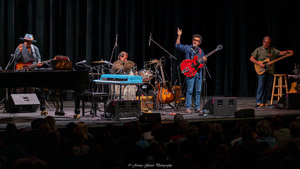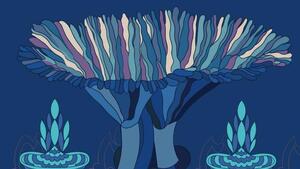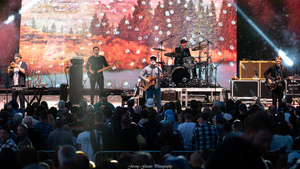
The Tree House (Nhà cây)
directed by Quý Minh Trương
starring Hậu Thị Cao, Lang Văn Hồ, Quý Minh Trương
Levo Films
Whilst living on the planet Mars in 2045, a filmmaker decides to capture the world around him. After a playback of sounds heard on Mars, the screen presents a Ruc woman speaking about the cave where she was born, followed by a HMong family eating dinner, followed by the disembodied voice of the filmmaker himself speaking with his father about their home. It seems that our filmmaker’s memory has begun to erode, and thus, he must make these calls to find a necessary glue to assemble the footage that he is capturing on the red planet with footage he has captured in the past in the hopes to reconstruct his own past on Earth, which is eluding him now as he sees his current surrounding terrain and recalls the homes and/or remnants of homes of the people he once interviewed. As the filmmaker journeys through the mountains of Vietnam with his camera, he presents the stories of Hậu Thị Cao of the Ruc people and Lang Văn Hồ of the Kor people, both of whom are from isolated ethnic groups who were forced to leave their homes. Ms. Cao once resided in a system of caves with her family and relocated from cave to cave in order to avoid being forcibly moved from her ancestral land and way of life, but eventually once the Vietnam War had ended, she and her family were forced to move to a constructed village by the North Vietnamese government. Similarly, Mr. Hồ lived in trees of a forest for decades with his father after the village where they called home was bombed, and in 2013, local authorities discovered him and his father and forced them to integrate into society.
In The Tree House (Nhà cây), director Quý Minh Trương skillfully and seamlessly blends the super 16mm images from cinematographer Son Doan and sounds from the day to day life and shared stories conveyed by Ms. Cao and Mr. Hồ with archival footage shot by the United States military during the war of the burning of the homes of the Kor people in Quảng Ngãi province, and then mixes all of this together with the whirling sounds of our director’s space journey to Mars and his reflections on filming communities far different from his own, all of which successfully functions in forming a timelessness that blurs the lines between past and present in order to allow us to sense how these multimedia forms and storytelling methods play into the construction of memory. By establishing this method early in The Tree House, Trương begins to suggest that although we believe that photography, film, and even drawing will help us preserve our memories, history and the subjects of the film have shown us that our reality and our memories stay with us most if we live in them or revisit them in our minds and dreams.
Furthering an assertion that we rely too heavily on physical media to construct memory, Trương narrates about his inability to recall any memories before the age of four, citing that the absence of photos taken of him prior to that age have led to the void early memory space. But, when Ms. Cao states that she remembers the moments during her own birth, this prompts the director to repeatedly ask her if that was indeed her own story, and when she insists that it was, Trương realizes that regardless of the veracity of her memory, it is still valid because any relayed (or even imagined) story and the memory have fused into one, and that combination may be stronger and truer to Ms. Cao’s experience than any footage capturing the moment of her birth. In turn, the director also suggests that the myriad of physical structures that the Ruc and Kor people inhabited, be it the tree house that Mr. Hồ and his father fled to, or the caves that Ms. Cao lived in, have become, in a sense, a home for memories to perpetually inhabit. Or, as evidenced by one of the Jarai tombs for the spirits of the dead, which were constructed and visited once by nearby communities, but lie unattended at the end, structures and their connected memories can symbolize the systematic dissolving of the traditions and even the languages that existed with these ethnic groups as they move away from their original homes. As The Tree House proceeds, it subsequently reveals a conundrum that Godard addressed in his feature from earlier this year, The Image Book, that is inherent in the production of all visual media being produced today: in an age when you cannot always trust what you see, what then is the need of capturing reality at all, especially when the act of capturing it pulls it away from the real and is inherently biased based on the capturer’s perspective?
And consequently, what if culture indeed is less preserved by filming than it is by the capturing and direct retelling of stories and experiences through people’s own memories? If film then serves any purpose according to the director, it is as a disruptive element between history and personal interpretation, and here, he would also argue that empathy is not created in documenting those moments because the camera places an outsider between the subject and the audience. To these ends, Trương presents a moment of accidental filming that occurs as he and his cinematographer walk with the camera unknowingly on and alludes to a contemporary of Godard’s, the late Agnès Varda, and a similar moment she called, “The Dance of the Lens Cap,” in her superb 2000 documentary The Gleaners and I where her unattended camera begins to film. As Varda ultimately depicts in her film, perhaps the accidental capture then becomes the sole unbiased way for the camera to remain as an observer and, consequently, the way for cinema to maintain its vitality.
As The Tree House culminates to an undetermined conclusion, the ideas of ownership of images, memories, and stories are fully brought to the forefront, and it is here that Trương questions his place to capture the stories of these people and make them into a film that will bear his own name. He doesn’t own their stories, their memories, so he maybe shouldn’t keep on trying to capture them and present them as a work of his own creation, but as the languages and cultures of these ethnic groups are vanishing, perhaps the need to document is more crucial than ever, and this open level of introspection that the filmmaker continues to raise throughout the work is the strength of The Tree House. With his clever use of his underlying science fiction construct, Trương can at least maintain an imaginary time and distance buffer between himself and his subjects, which allows him (and us as the audience) to observe them as objectively as possible while simultaneously examining the current implications of the necessity of cinema.
But, with such an experiment, does Trương trivialize the lives of Ms. Cao and Mr. Hồ and the HMong and Jarai communities, whose stories and images are the elements used to construct his discourse on the documentation and preservation of reality and memories? Trương confesses the problematic nature of his position as an outsider and filmmaker, but his admission doesn’t prevent him from ultimately creating and presenting the film he wants. And in the execution of his concept, we see vignettes of his subjects, enough to keep us engaged but not enough to leave the film with any belief that we’ve deeply explored the history and culture of the Ruc, Kor, HMong, or Jarai people. As a result of this approach, the director avoids creating a sterile ethnographic work where we are passive, distant viewers and leaves us with a series of questions that lead us toward an analogous discomfort about our own role as the audience and how we use image, sound, and word to believe that we understand worlds far beyond our own after seeing a film.
Thus, in The Tree House, Trương gives enough basic knowledge and instills enough curiosity in us that at the end, if we want to we go out and learn more about his subjects, that exploration is now our own responsibility. But, he has armed us with skepticism for any media we consume where an outsider is placed between a subject and skepticism for our own desires to interrupt worlds where we do not belong as we seek experiences as visitors who will most certainly leave. The Tree House isn’t a documentary that we could ever walk out of feeling like we necessarily learned a lot about the history and current plights of minority ethnic groups of Vietnam, but it is a documentary where we as audience members are made to feel more responsible and curious about our experiences of home, our motivations for our intrusion into others’ homes and memories, and our obsession with capturing reality. That’s an enormous victory for any piece of art.
◼












